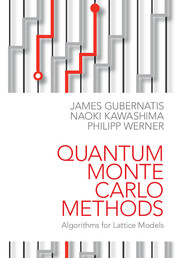Book contents
- Frontmatter
- Contents
- Preface
- Part I Monte Carlo basics
- Part II Finite temperature
- Part III Zero temperature
- Part IV Other topics
- Appendix A Alias method
- Appendix B Rejection method
- Appendix C Extended-ensemble methods
- Appendix D Loop/cluster algorithms: SU(N) model
- Appendix E Long-range interactions
- Appendix F Thouless's theorem
- Appendix G Hubbard-Stratonovich transformations
- Appendix H Multi-electron propagator
- Appendix I Zero temperature determinant method
- Appendix J Anderson impurity model: chain representation
- Appendix K Anderson impurity model: action formulation
- Appendix L Continuous-time auxiliary-field algorithm
- Appendix M Continuous-time determinant algorithm
- Appendix N Correlated sampling
- Appendix O The Bryan algorithm
- References
- Index
Preface
Published online by Cambridge University Press: 05 May 2016
- Frontmatter
- Contents
- Preface
- Part I Monte Carlo basics
- Part II Finite temperature
- Part III Zero temperature
- Part IV Other topics
- Appendix A Alias method
- Appendix B Rejection method
- Appendix C Extended-ensemble methods
- Appendix D Loop/cluster algorithms: SU(N) model
- Appendix E Long-range interactions
- Appendix F Thouless's theorem
- Appendix G Hubbard-Stratonovich transformations
- Appendix H Multi-electron propagator
- Appendix I Zero temperature determinant method
- Appendix J Anderson impurity model: chain representation
- Appendix K Anderson impurity model: action formulation
- Appendix L Continuous-time auxiliary-field algorithm
- Appendix M Continuous-time determinant algorithm
- Appendix N Correlated sampling
- Appendix O The Bryan algorithm
- References
- Index
Summary
Fast computers enable the solution of quantum many-body problems by Monte Carlo methods. As computing power increased dramatically over the years, similarly impressive advances occurred at the level of the algorithms, so that we are now in a position to perform accurate simulations of large systems of interacting quantum spins, Bosons, and (to a lesser extent) Fermions. The purpose of this book is to present and explain the quantum Monte Carlo algorithms being used today to simulate the ground states and thermodynamic equilibrium states of quantum models defined on a lattice. Our intent is not to review all relevant algorithms – there are too many variants to do so comprehensively – but rather to focus on a core set of important algorithms, explaining what they are and how and why they work.
Our focus on lattice models, such as Heisenberg and Hubbard models, has at least two implications. The first is obviously that we are not considering models in the continuum where extensive use of quantum Monte Carlo methods traditionally has focused on producing highly accurate ab initio calculations of the ground states of nuclei, atoms, molecules, and solids. Quantum Monte Carlo algorithms for simulating the ground states of continuum and lattice models, however, are very similar. In fact, the lattice algorithms are in many cases derived from the continuum methods. With fewer degrees of freedom, lattice models are compact and insightful representations of the physics in the continuum.
The second implication is a focus on both zero and finite temperature algorithms. On a lattice, it is natural to study phase transitions. In particular, the recent dramatic advances in quantum Monte Carlo lattice methods for the simulation of quantum spin models were prompted by a need for more efficient and effective ways to study finite-temperature transitions. While quantum Monte Carlo is profitably used to study zero temperature phase transitions (quantum critical phenomena), some ground state algorithms have no finite temperature analogs and vice versa. In many respects, the lattice is where the current algorithmic action is.
The book is divided into four parts. The first part is a self-contained, more advanced than average, discussion of the Monte Carlo method, its use, and its foundations.
- Type
- Chapter
- Information
- Quantum Monte Carlo MethodsAlgorithms for Lattice Models, pp. xi - xivPublisher: Cambridge University PressPrint publication year: 2016



